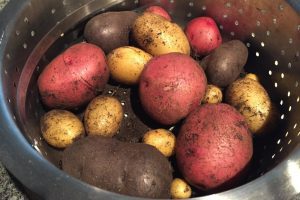Potato towers are a great way to grow more potatoes in limited space!
I love potatoes, but growing rows of them is not an option in my small garden. An average plant can be up to three feet tall and one foot wide, which is a lot of real estate in a tiny urban garden. Then I learned about potato towers. They are the perfect solution for my potato cravings and small garden.

What are potato towers?
Generally, potato towers are 2 to 4 feet tall and are cylinders of chicken wire filled with soil. The idea is that the potatoes will form all along the stem as they grow up the tower. This saves space and eliminates hilling, a technique in which soil is continually piled up around the base of a plant to promote growth.
What do I need to build a potato tower?
The first thing you need for a potato tower is a location in full sun with easy access to water. Next, buy some seed potatoes from a reputable nursery. The best varieties for a potato tower area are mid- to late-season potatoes specific to your region. Next, you will need wire fencing or chicken wire, zip ties, straw (not hay!), garden soil mixed with compost, pliers, and a shovel. Most towers are three or four feet tall.
How to build a potato tower
Form a circle with the fencing and secure the ends with zip ties. You can also twist the wires together to form a cylinder that is 18 inches (46 cm.) across. Secure the tower to the ground with tent pegs or tie it to a structure such as a fence. If left free-standing, it can blow over in the wind, and you’ll have to start over again.

Planting the potato tower
Cut the seed potato into pieces with two to three sprouting eyes (chits) on each piece. Add a bottom layer of straw followed by soil and lay the first layer of potatoes on top of the soil around the tower’s edges, spacing them 4 to 6 inches (10-15 cm.) apart with the chits pointing towards the wire fencing. The layers between the potato plantings should be at least a foot to a foot and a half. Water the layer until moist but not saturated, and repeat the process until you reach about 4 inches (10 cm.) from the top of the tower.
Watering your potato tower
Water the tower from the top for the surface layers. Ensure the bottom layers are moist, and stick the hose’s nozzle through the sides. Always check the soil before watering, as too much water will cause the new baby potatoes to rot.
Harvesting from the potato tower
As the growing season progresses, you will notice the tops of the potatoes slowly making their way out of the side of the towers. This is a sure sign that potatoes are growing in your bottom layers. When the tops of the potatoes start to die off, it’s time to harvest. The easiest way to harvest the potatoes is to tip the whole tower over, cut the frame, and sift through the dirt to get the potatoes out.